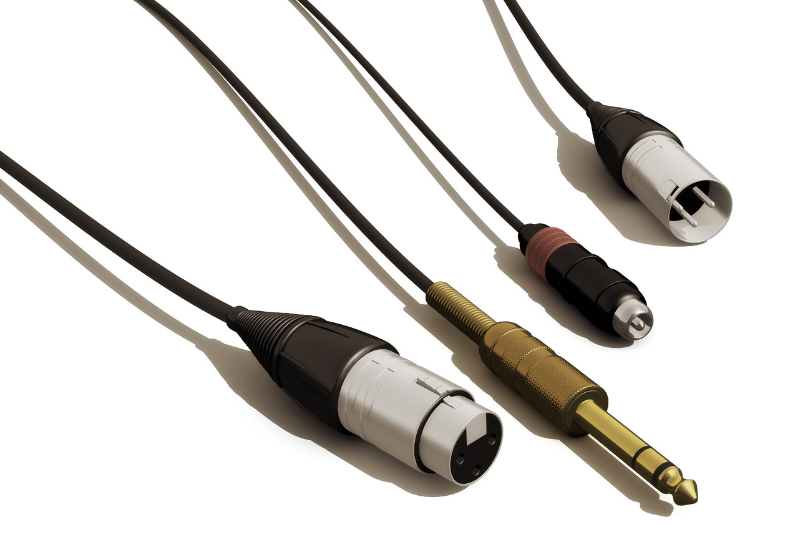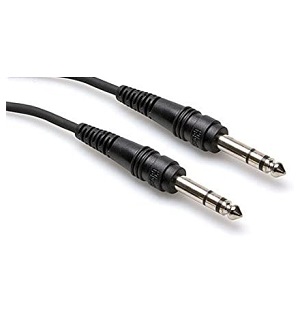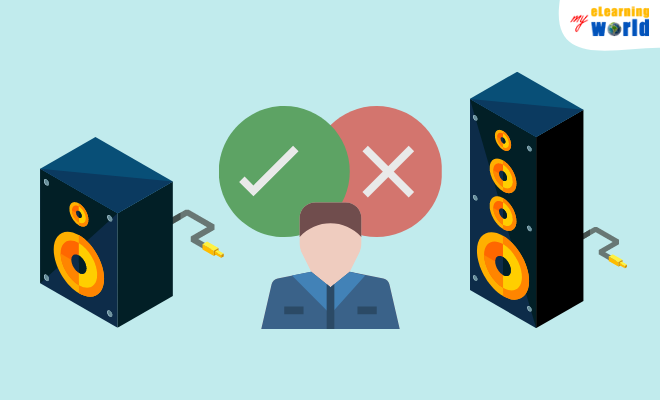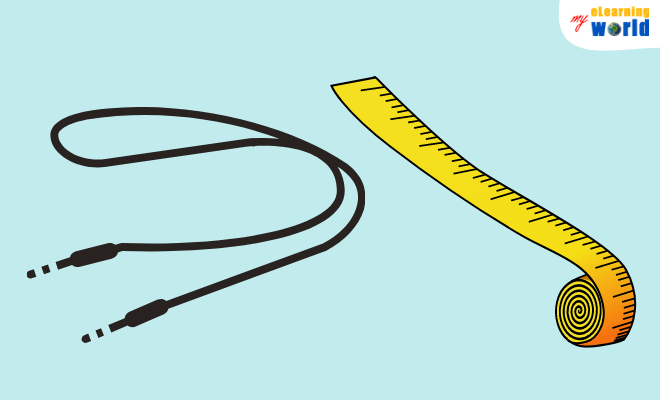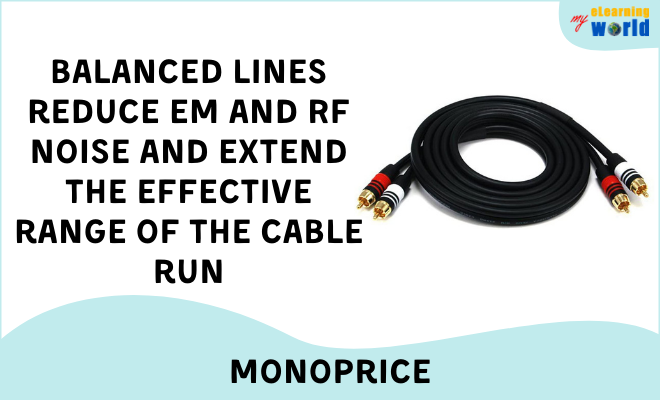The best cables for studio monitors can help you get the best sound quality from your recording and mixing sessions.
Studio monitors are some of the most important tools a recording engineer or audio enthusiast can have. Dedicated monitors provide accurate feedback while recording, but they also make a world of difference when mixing and mastering.
What I’ve learned over the many years I’ve spent in the studio is that people who are new to the world of recording are often confused about connecting monitors. After all, monitors look like regular speakers, so shouldn’t you just be able to plug into them like a regular speaker?
The truth is that different monitors have different inputs designed to meet various audio needs. The most common connections you’ll encounter are XLR, TRS (balanced 1/4-inch), and RCA (unbalanced), each with its unique purpose:
- XLR connections are the industry standard for professional setups, offering balanced audio with excellent noise rejection—ideal for longer cable runs.
- TRS (Tip-Ring-Sleeve) is another balanced option often found on both monitors and audio interfaces. It’s versatile and works well for home studios and professional environments alike.
- RCA is typically used in consumer-grade equipment or older setups and is unbalanced, making it more prone to interference.
- Some higher-end monitors and interfaces now support AES/EBU, a digital audio standard that provides superior fidelity over balanced XLR connections.
As technology evolves, newer monitors may also incorporate USB-C or other digital audio input options, though these are still less common in 2025.
On top of that, you’re going to need the right cables to connect your monitors to your audio interface or computer.
Whether you are a professional or just starting out, having the right cables is essential for achieving that perfect balance between clarity and richness in your recordings.
With so many different types of cables available, it can be difficult to decide which ones are best for your specific needs.
To take some of the mystery out of selecting the right cords for your monitors, I tested nearly 50 products. While all had something to offer, I found 15 that I want to pass along to you in order to help you create better audio.
In this article, you’ll learn about:
How to select the right studio monitor cables
Features of some of the best cables
Tips for cable management
Must-have accessories to complete your recording experience
I should also note that although I’ve only included my reviews for the best cables, there were some that I tested that were still good, despite not making my list.
Because of my preference for wired connections in the studio, I reviewed products that offered a physical-only option. Some audio gear can utilize both wired and wireless links, but I’m concerned with physical cabling for the purposes of these reviews.
This guide has been fully updated for 2025 to provide you with the best current options on the market so you can choose wisely.
Disclosure: Some of the links in this article are affiliate links, meaning at no additional cost for you, we might get a commission if you click the link and purchase.
Quick Picks for the Best Studio Monitor Cables
Don’t feel like reading my full guide? Here are a few of my absolute top choices for the best studio monitor cables available in 2025…
My Top Pick
Сable Matters XLR to XLR
What’s inside?
- Oxygen-free copper construction: Delivers low-noise, high-fidelity audio transmission, ensuring the cleanest signal possible.
- Balanced cabling with a flexible PVC jacket: Reduces interference while offering durability and ease of use in studio setups.
- Lengths up to 20 feet: Ideal for a range of studio configurations, from compact setups to larger environments.
Killer feature: Gold-plated contacts provide exceptional resistance to oxidation, ensuring consistent sound quality and long-lasting performance.
When selecting audio cords for studio monitors, keep in mind that many cables are versatile and can serve multiple purposes. For instance, XLR cables often work just as well for connecting microphones to audio interfaces as they do for linking monitors, while TRS cables can handle everything from studio monitors to guitars and amps.
Because of this flexibility, it’s always a good idea to keep a few extra high-quality cables on hand. Even if they’re not exclusively dedicated to your monitors, having spares ensures you’re ready for any setup changes or unexpected needs.
Also Great
Hosa CSS-110 TRS to TRS
What’s inside?
- Balanced wiring minimizes electronic interference for clear audio transmission.
- TRS (Tip-Ring-Sleeve) design works seamlessly with audio interfaces, monitors, and other hardware.
- Available in lengths up to 25’.
Killer feature: The lightweight 1.6-ounce construction is perfect for portable setups, easy storage, and hassle-free transport.
Cable Labeling Tip:
Labeling your cables can significantly improve workflow efficiency, particularly in studios with multiple audio devices. To avoid confusion, write the source or destination name on each cable using a small label or strip of paper and tape it securely. You can also use color-coded labels or pre-made cable tags to streamline the process even further.
Also Great
Monoprice TRS to XLR
What’s inside?
- Thick 16AWG wiring for durability and high power transmission
- Gold-plated TRS tip for better conductivity and corrosion resistance
- Available in lengths up to 50
Killer feature: Separate braided shield for superior noise reduction, preventing interference in professional environments
Safety Tip:
Be cautious when hanging cables, particularly those connected to audio equipment. A cable snag can not only damage your gear but also pose a safety risk, leading to potential falls or injuries. Consider securing cables with cable organizers or hooks to prevent tripping hazards.
What to Consider When Shopping for the Best Studio Monitor Cables
You might think that all studio monitor cables are created equal, but several key factors can determine whether a cable is right for your needs. Cables come in various thicknesses, often measured by gauge. The wire gauge inside a cord determines the amount of current it can handle. A cable with too thin of a gauge may not deliver optimal performance, while one that’s too thick could unnecessarily increase costs without providing much benefit, especially for shorter distances.
As technology evolves, modern cables are typically designed to strike a balance between flexibility and performance. When choosing cables, especially for longer runs, it’s worth opting for cables with thicker gauges to maintain signal integrity.
Because cabling solutions vary widely, here are some tips to help you find the right products for your studio’s needs:
Step 1: Analyze Your Budget
I almost always start any audio purchasing decision by analyzing my budget. Knowing how much you have to spend is essential but consider how much a purchase will contribute to your long-term needs. In some cases, making a bigger purchase now may save you money in the future by providing more reliable performance, especially if it improves your overall workflow or sound quality.
Step 2: Choose Between Balanced Cables and Unbalanced Cables
Audio cables typically come in two different types: balanced cables and unbalanced cables. Which one works best depends on how you’re using the cables, and your equipment needs.
Explanation of Balanced vs. Unbalanced Cables:
- Unbalanced Cables: These use two wires: a signal wire and a ground wire. Common in RCA cables and TS cables, they are suitable for shorter distances and less sensitive to interference.
- Balanced Cables: These feature two signal wires and one ground wire. The signal wires carry inverted audio signals, which help cancel out any noise picked up during transmission. This makes balanced cables perfect for longer cable runs and high-quality setups, as they provide better protection against signal degradation and interference.
Unbalanced Cables
These are commonly found in consumer-grade equipment or older setups. RCA is a common unbalanced connection, which is susceptible to noise and interference, making it less ideal for high-quality professional studio setups. However, for shorter connections, unbalanced cables may still work fine.
Balanced Cables
These are more common in professional audio setups and include connectors like XLR and TRS (Tip-Ring-Sleeve). Balanced cables are excellent for rejecting noise and interference, especially over longer distances, which is why they’re ideal for studio monitors. However, not all audio equipment supports balanced connections, so it’s essential to check your gear’s requirements.
Step 3: Choose the Type of Connectors You Need
Once you’ve figured out your budgeting and have decided between balanced and unbalanced cables, you’ll need to consider the type of connectors you need. Here are some common connector configurations:
- XLR to XLR
- TRS to XLR
- TRS to TRS
- TS to TS
- RCA to RCA
- RCA to XLR
The right connector depends on the input requirements of your gear. Many manufacturers provide specific recommendations in their product documentation, which should guide you to the right type of connection for your equipment.
Step 4: Consider the Length of the Cables You Need
Finally, consider the length of each cable based on your studio setup. Shorter cables generally result in better sound quality, as they reduce the chances of signal interference. Longer cables, while sometimes necessary, can introduce signal noise or even slight delays, which could affect audio syncing.
When purchasing cables, always account for your studio’s layout and choose cables that provide the right balance of length and performance.
What are the Best Studio Monitor Cables?
Here are all of my choices for studio monitor cables worth trying in 2025…
 |
Best for studio monitor connections and microphones. Category: XLR to XLR
My top pick for XLR to XLR connections!
|
Amazon →Cable Matters → |
 |
Best for female-to-male XLR monitor connections. Category: XLR to XLR
Top recommendation for robust and reliable XLR connections.
|
Amazon →Sweetwater → |
 |
Best for outputting audio from TRS connections directly to monitors. Category: TRS to XLR
Ideal choice for converting TRS to XLR with great clarity and minimal interference.
|
Amazon → |
 |
Best for patching connections between monitors and TRS interfaces. Category: TRS to XLR
A reliable choice for clean audio transmission with solid durability.
|
Amazon → |
 |
Best for making shorter connections between monitors and XLR/TRS outputs. Category: TRS to XLR
My top pick for TRS to XLR connections, offering reliable performance at a great value.
|
Amazon → |
 |
Best for connecting audio interfaces to studio monitor inputs. Category: TRS to XLR
A great choice for high-quality, balanced audio connections between your interface and monitors.
|
Amazon → |
 |
Best for cost-effective patching connections between monitors or patch bays. Category: TRS to TRS
Ideal for budget-conscious setups while still providing solid, reliable connections.
|
Amazon → |
 |
Best for patch bays and outputs to studio monitors. Category: TRS to TRS
Durable and versatile, perfect for linking your patch bays or connecting to studio monitors for clear, interference-free audio.
|
Amazon →Seismic Audio → |
 |
Best for intermediate balanced connections between monitors and interfaces. Category: TRS to TRS
My choice among TRS to TRS connections! Known for its high-quality, balanced wiring that minimizes interference.
|
Amazon →Hosa → |
 |
Best for stereo connections that require interconnected dual cabling. Category: TS to TS
A great option for stereo setups, featuring high-quality construction for clear, balanced audio.
|
Amazon →Hosa → |
 |
Best for general patching between instruments, interfaces and studio monitors. Category: TS to TS
Features color-coded connectors for easy organization and high-quality construction for reliable performance.
This cable is well-regarded for its durability and clarity, making it a solid choice for various studio applications.
|
Amazon → |
 |
Best for studio monitors that accept two-channel RCA inputs. Category: RCA to RCA
Well-suited for delivering high-quality stereo audio signals, this cable provides clarity and durability. Available in multiple lengths to fit your setup.
|
Amazon →Walmart → |
 |
Best for studio monitors that accept two-channel RCA inputs. Category: RCA to RCA
This cable offers reliable signal transmission with gold-plated connectors for enhanced durability and corrosion resistance. Available in various lengths to suit your setup.
|
Amazon → |
 |
Best for patching monitors and portable recorders and converters. Category: RCA to XLR
Well-suited for connecting RCA outputs to XLR inputs with a durable design, this cable ensures clear and reliable signal transfer. Available in various lengths to accommodate your setup.
|
Amazon → |
 |
Best for sending audio from mixing consoles to studio monitors using RCA/XLR. Category: RCA to XLR
Designed for high-quality audio transfer, this cable delivers clear sound from mixing consoles to monitors, offering durability and reliability. Available in multiple lengths to fit your studio configuration.
|
Amazon → |
Below, I’ve reviewed 10 of the 15 best cables for studio monitors from a variety of manufacturers. In my testing, I evaluated not only how well these cables performed but also their durability, wire thickness, and the range of lengths available.
When reviewing, I tested a number of different connections because I know that everyone has their own preference when it comes to choosing studio monitors. Some monitors accept RCA connections only, but others use connections that accept 1/4” TRS and TS cables.
Because of the importance of studio monitors cables, I took the time to try out different brands to find the best. I also tried a number of different connection types across different monitors so that I could hear the difference each made for myself.
XLR to XLR
These are the best XLR to XLR models that I chose.
1. Cable Matters

I tried out the Cable Matters XLR cables with a variety of monitors for mixing. I liked that these came in two packs as it reduced my overall costs.
In terms of clarity, I found the signal to be perfectly clear. In fact, I had to double check my monitors and playback as I’m used to a warmer sound from other cables.
The length was perfect for my setup from the mixing console to the monitors; however, if you’re using monitor stands or have your monitors positioned further away, you may need to purchase longer models.
One nice thing about these cables is that they can be used for a variety of purposes. If you work in any type of live sound or film work in the studio, these cables can also be hooked up to DMX lighting as well as microphones and monitors.
Features
- Gold plating on XLR pins
- Strain relief on connectors
- Compatible with DMX lights
- Individual wire insulation
- Available in lengths up to 20’
Pros
- Available in packs of two
- Can be used with camera mics
- PVC jacket is very durable
- Grip threads reduce connection loosening
Cons
- No color coding
- Signal clarity may be fatiguing

Best For: Connecting interfaces to monitors and mics to interfaces
Killer Feature: Copper braided shielding eliminates hum and interference
In this video, Sean Divine walks you through how to select the right studio cables for a variety of different pieces of gear. Sean provides insight regarding balanced and unbalanced cables as well as how each performs during recording.
I don’t usually concern myself with the type of metal used for the wiring of my cables because most of it will be copper anyway; however, gold plating on some metal used in audio gear can resist corrosion.
Buying Options
2. Mogami
One of the nice things about Mogami’s XLR cable is that it is designed specifically for studio use. There is a stage version available, but it incorporates a slightly different feature set.
When testing these cables in the studio, I found the audio reproduction to be crisp and clear. I experienced no signal noise or RF interference, and I have a number of WiFi enabled devices around.
The cables feel well-made and sturdy with no difficulty in attaching, detaching or connection grip. I would caution that these cables are meant to remain out of the way as rough handling could cause separation of the shielding.
If you’re planning to use these to connect monitors in a live environment, I would recommend the stage version instead.
Features
- Incorporates four conductors for extra isolation
- Can be used with powered monitors
- Balanced design reduces noise by 95%
- Utilizes oxygen-free copper
- Available in lengths up to 100’
Pros
- Can be used with isolated subwoofers
- Includes lifetime warranty
- Works with vocal effects processors
- Designed specifically for studio use
Cons
- A bit heavy at almost a pound
- Shielding is prone to separation from rough handling
Best For: Making XLR connections for monitors and preamps
Killer Feature: Quad-conductor design reduces RF interference and noise
A wired connection will almost always deliver a more consistent experience compared to wireless. This is especially true when using microphones, including those that utilize XLR. You can learn more about the best XLR microphones in this article.
Buying Options
TRS to XLR
These are the best TRS to XLR models that I chose.
3. EBXYA
Connecting TRS outputs to XLR inputs can be a challenge, but the EBXYA TRS-to-XLR cables made things easy. I had no issues making a connection between my interface output to my monitors, and the connections felt very secure with no wiggle.
Sound reproduction was faithful to the source material across a variety of monitors in the studio. I didn’t experience any RF interference, and I think this is owed to the double shielding incorporated in the design.
The connectors are made from a zinc alloy. While I only tested these cables for a short time, my experience tells me that they will remain durable for many years to come.
Best For: Connecting mixer consoles and monitors in-studio
Killer Feature: Zinc alloy XLR connector is durable for longer use
Features
- Available in packs of two
- Includes Velcro management
- Dual shielding for added isolation
- Balanced Lo-Z
- TRS is plated with 24k gold
Pros
- Can be used as a patch cable
- Additional male/female configurations available
- Utilizes oxygen-free copper
- Can connect additional audio gear
Cons
- A bit more expensive compared to other options
- No color coding available
Although it may be tempting to wrap your cables from your hand to your elbow to save time, this can damage cables. Instead, coil loose cables over your palm in small sections to allow for some slack.
Buying Options
4. DISINO
The DISINO 1/4” TRS-to-XLR cords I received felt very durable and professionally manufactured. I didn’t have much experience with the brand, but I was pleasantly surprised by these products.
When used with my studio monitors, I experienced very little in the way of hum. This may have been interference, but I think it may have also been an electrical issue on my end.
After checking all of my connections, the rest of my time was relatively noise-free. One nice thing about these cords is that they utilize 20AWG for the wiring. I think the thickness works well and improves the audio transfer across longer lengths.
Features
- Copper wiring is 20AWG
- PVC jacket wrapping
- Gold-plated TRS tip
- Rubberized booty at cord connection
- Available in lengths up to 15’
Pros
- 360-degree grip threading
- Includes Velcro cable wrap
- Works with a variety of audio gear
Cons
- Connections may be a bit tight
- A bit more expensive than comparable products
Best For: Connecting 1/4” outputs to XLR monitor inputs
Killer Feature: Oxygen-free copper resists corrosion for durability
If a piece of debris is blocking a cable input, never force a connection. Instead, consult your gear’s manual and manufacturer to discuss solutions to safely remove the debris.
Buying Options
TRS to XLR
5. Cable Matters

Cable Matters makes some great products, and the brand’s TRS-to-XLR option I tried was no exception. I found the manufacturing to be solid, and the product felt durable in my hands.
Cable Matters continues to be a strong contender in the audio cable space, and their TRS-to-XLR option is no exception. The build quality remains solid, and the product feels durable and long-lasting.
When making a connection between TRS and XLR, connection fit is key, as even a slight offset can lead to performance issues. With these cables, I found the connection to be secure with no jiggling or excessive force required. Once the connector clicks into place, it remains stable with no interference throughout testing, delivering clear and reliable audio across all studio monitors I used.
Features
- Oxygen-free copper
- Flexible PVC jacket
- Polyethylene insulation
- 360-degree grip threads
- Available in lengths up to 50’
Pros
- Versatile, suitable for a variety of connections
- Foil shielding for improved signal integrity
- Pro model features balanced design for reduced noise
- Molded strain relief ensures longevity and durability
Cons
- No color options for personalization
- Potential for hum if the conductor touches metal

Best For: Establishing solid connections between studio monitors and 1/4” audio outputs.
Killer Feature: The gold-plated connectors housed in a PVC jacket make for a durable, long-lasting connection that stands the test of time.
In this video, Kennis Russell demonstrates various types of cables and connectors used in studio environments. He provides guidance on selecting the right cable to meet your studio’s needs.
As a side note, it’s essential to ensure connectors stay in proper alignment. Even a slight bend can significantly impact performance. While it’s sometimes possible to straighten a bent connector using hand tools, if it’s warped out of position, replacing the cable may be the best solution.
Buying Options
TRS to TRS
These are the best TRS to TRS models that I chose.
6. Seismic Audio

When it comes to studio gear management, I’m a big fan of using color-coded cables. This system allows me to quickly identify connections without relying on handwritten notes or tracing wires manually.
The Seismic Audio SATRIX cables were perfect for this purpose since they’re available in a variety of color combinations. Using these cables with my monitors and patch bay, I found my workflow noticeably more efficient and productive.
In terms of sound quality, I experienced no interference with any of the cables I tested. I also appreciated the flexible rubber jacket, which felt durable yet soft, making the cables easy to handle and route.
Features
- Balanced design to minimize interference
- Fiberglass insulators
- 22AWG wiring for improved performance
- RF rejection for cleaner sound
- One-year warranty
Pros
- Wide range of color options for easy organization
- Durable and flexible rubber jacketing
- Oxygen-free copper for better signal transmission
- Versatile for connecting more than just monitor
Cons
- Limited to a 6-foot length
- May require adapters for certain setups

Best For: Patch bays and monitor connections in smaller studios
Killer Feature: Over 15 color sets available to label inputs and outputs with ease
Using color-coded cables to organize your studio not only improves efficiency but also reduces potential connection errors. If different colored cables aren’t feasible, you can use small, color-coded tags or labels on your existing cables to achieve a similar result.
Buying Options
7. Hosa CSS-110

Testing the Hosa CSS-110 TRS cables gave me the chance to try out a brand I’ve rarely used, as Hosa is primarily known for DJ and live audio gear. While the design of these cables is fairly basic in appearance, they feel well-constructed and surprisingly durable for their price point.
I tested these cables with several pairs of studio monitors. Since these are TRS-to-TRS, they’re not compatible with monitors requiring XLR connections. However, Hosa offers various connector types, so you can likely find a solution to match your specific gear.
These cables performed well for audio playback, making them a reliable option for monitoring or mixing tasks. While I wouldn’t use them for recording an audio source where quality loss could be critical, they held up fine for audio reproduction where the final product isn’t affected.
For most studio setups, I recommend the 3-foot or 5-foot lengths. Longer lengths are available but may introduce minor signal degradation unless carefully managed.
Features
- Nickel-plated plugs for durability
- Oxygen-free copper for cleaner signal transfer
- Spiral shielding to minimize interference
- Lightweight design at under two ounces
- Available in lengths ranging from 3 feet to 25 feet
Pros
- Effective at rejecting electromagnetic interference
- TRS design offers improved shielding over unbalanced cables
- Compatible with adapters for converting signals
Cons
- Not compatible with 3.5mm inputs without an adapter
- Unsuitable for head-to-cabinet amplifier connections

Best For: Larger mixing areas and medium home studios
Killer Feature: 10-foot length allows for flexible setups without excessive slack
If you’re looking for an affordable, dependable cable for playback or monitoring in a studio environment, the Hosa CSS-110 offers solid performance. For added insight into cable use, watch Pete Johns from Studio Live Today discuss balanced vs. unbalanced cables and best practices for home studio setups.
Buying Options
TS to TS
These are the best TS to TS models that I chose.
8. Hosa CPP-201

The Hosa CPP-201 Dual 1/4”-to-1/4” stereo line cables offer a straightforward and efficient solution for stereo connections. The color-coded design is particularly useful when managing stereo sound, making it easy to identify left and right channels at a glance.
While these cables aren’t compatible with studio monitors requiring XLR connections, they perform exceptionally well for connecting left and right channels using basic TS inputs and outputs.
During testing, I didn’t notice any hum or electrical noise, and the sound quality was on par with more expensive professional-grade cables. However, keep in mind that these cables are unbalanced, meaning they’re best suited for short distances to minimize interference.
Features
- RF and EMI resistance for cleaner signals
- Oxygen-free copper conductors resist corrosion and maintain sound integrity
- Nickel-plated plugs enhance durability and connection stability
- Spiral shielding reduces interference
Pros
- Color-coded wires simplify stereo management
- Can separate wires for flexible setups
- Budget-friendly price without compromising quality
Cons
- Not ideal for professional-grade audio recording
- Limited compatibility with microphones or XLR-reliant setups

Best For: Unbalanced stereo connections between short distances
Killer Feature: Oxygen-free copper conductors deliver improved sound clarity
If you’re considering making your own connectors by soldering wires, be cautious—while it might seem cost-effective, improper soldering can damage your equipment and void any cable warranties. For most users, a reliable option like the Hosa CPP-201 is the smarter and safer choice.
Buying Options
RCA to RCA
These are the best RCA to RCA models that I chose.
9. Monoprice RCA to RCA
The Monoprice Premium RCA-to-RCA cables offer a practical and durable solution for devices requiring RCA connections. With their flexible yet sturdy build, they’re easy to handle without compromising durability. The standard red and white color coding ensures seamless organization and tracking of inputs and outputs.
In my testing with monitors that accept RCA connections, the sound was clear and accurate, with no noticeable color or distortion. However, as with all RCA connections, ensuring a secure ground is crucial to avoid buzzing. Fortunately, the Monoprice cables formed a reliable, tight connection, even with regular use.
Although I generally prefer thicker gauges, the 22AWG wiring performed admirably, with no noticeable impact on sound quality. These cables strike a balance between flexibility and durability, making them a solid choice for various studio setups.
Features
- 22AWG wiring for reliable performance
- RG-59 75-ohm coaxial construction
- Gold-plated conductors for reduced signal loss
- Rubberized rings for secure connections
- Backed by a lifetime warranty
Pros
- Standard red and white color coding for easy identification
- Wires can be separated for customized setups
- Available in lengths up to 75’ for flexible use
Cons
- Not suitable for in-wall installation
- Unbalanced, which may limit some applications
Best For: Stereo connections between studio monitors and portable players or recorders
Killer Feature: 22AWG wiring enhances conductivity for improved performance
Pro Tip: Always ensure RCA connections click into place securely. A loose connection can introduce noise, static, or even intermittent sound loss. If you don’t hear or feel a click, recheck the connection to maintain optimal performance.
Buying Options
RCA to XLR
These are the best RCA to XLR models that I chose.
10. TISINO
While I usually prefer plastic shielding or similar materials for cable connectors, the TISINO RCA-to-XLR cables performed reliably in my tests. The only precaution is ensuring the conductors don’t come into contact with the metal housing, as this could introduce noise.
These cables felt solid and durable, with a flexible rubber and nylon braid that resists tangling. The color-coded design makes it easy to identify and organize connections. I used these cables to connect stereo outputs from digital recorders and audio interfaces to monitors without encountering any issues.
The sound reproduction was clean and faithful, with no noticeable colorization or tone loss. While I detected a slight digital crispness, this is common with most digital recordings today. For most setups, the three-foot model is ideal, as the six-foot version may be unnecessarily long depending on monitor placement and studio layout.
Features
- 20AWG 4N oxygen-free copper for enhanced sound clarity
- Flexible rubber and nylon braid construction
- Polyethylene insulation for reduced interference
- Lengths available up to 10 feet
Pros
- Flexible design minimizes tangles
- Color-coded for easy organization
- Can connect a wide variety of devices
Cons
- RCA connectors may buzz when plugged/unplugged
- Metal housing may introduce noise if wires contact it
Best For: Connecting audio players, preamps, and studio monitors in small to medium studios
Killer Feature: 20AWG oxygen-free copper ensures superior sound clarity
Pro Tip: If you’re recording in the same room as your monitors, consider using studio headphones to avoid feedback or environmental noise. Sound treatments like curtains can also help isolate your audio source and enhance your recording quality.
For more insights on optimizing your studio space, check out this article on the best soundproof curtains for recording studios.
Buying Options
Other Must-Haves
Even the best monitors and cables can only take you so far in recording and production. With just the bare essentials, your capabilities—and the types of projects you can take on—will be limited.
To truly unlock your studio’s potential and stay ahead in 2025, consider these additional must-have essentials:
Monitor Stands
The placement of your monitors plays a crucial role in the quality of your sound. If your monitors aren’t positioned properly—at ear level and separated at the correct width—your perception of the audio output may be skewed, leading to less accurate mixes.
While you can technically place your monitors on any flat surface during recording and mixing, investing in a quality pair of monitor stands is highly recommended. Modern monitor stands not only allow you to position your monitors exactly where you need them but also offer advanced features like adjustable height, tilt, and rotation for optimal sound projection. Many stands now include built-in vibration isolation to further enhance audio accuracy.
For 2025, keep an eye out for stands designed with smart features, like cable management systems and modular designs that adapt to different setups.
Buying Options
Studio Headphones
While monitors are essential for mixing, a good pair of studio headphones is invaluable during the recording phase. They allow me to monitor a performance in real-time, catching any mistakes and correcting them before they become a problem in post-production.
Studio headphones are also ideal when recording on-the-go or when I need to listen at a lower volume with precise control. Modern studio headphones can replicate the clarity and accuracy of high-end monitor setups, making them a must-have for any serious producer.
For 2025, it’s worth investing in headphones that offer features like active noise cancellation, high-fidelity sound reproduction, and more comfortable, longer-wear designs. Look for headphones that are engineered specifically for studio use, as opposed to retail headphones made for casual music listening. This ensures a more accurate, flat response that helps you catch even the smallest nuances in your recordings.
Buying Options
Acoustic Treatment
Achieving the right acoustic balance in a studio is crucial—not only for recording but also for mixing. Even the best monitors can sound off if your studio isn’t properly treated with acoustic foam, bass traps, and other sound isolation solutions.
Acoustic treatment is a nuanced and technical area that really deserves its own deep dive. But at the very least, investing in some level of treatment will help you get the most accurate sound possible from your monitors.
When it comes to 2025 acoustic treatment, it’s all about a hybrid approach. Along with traditional foam and bass traps, newer products like diffusers and hybrid panels are becoming more popular. These elements can help scatter sound waves more effectively, reducing unwanted reflections and boosting clarity in both the low and high-frequency ranges.
Remember, every hard surface in your room serves as a potential reflection point, so think about how and where you place your monitors. In addition to wall treatments, consider ceiling and floor treatments for an all-around balanced sound.
Buying Options
Useful Resources
- Powered speakers vs. studio monitors: what’s the difference?
- Active vs passive studio monitors: which is which?
- 11 ways to improve your home studio monitoring setup
- Studio monitors. Do I need a subwoofer or larger monitors?
- The best home studio monitors
Conclusion
The best gear isn’t always the most expensive.
As I’ve learned over the years, particularly in large studio environments, the best gear doesn’t always come with a hefty price tag. Often, you can achieve the same results with moderately priced equipment as you can with high-end options.
This holds true for cables as much as it does for other studio gear, like headset microphones. The key is reliability—cables that deliver clear, interference-free performance regardless of cost are the ones that will serve you best.
In today’s rapidly evolving tech landscape, it’s important to prioritize functionality and durability over flashy features or premium pricing. Quality gear is all about doing the job right, no matter what your budget is.
If you’re interested in diving deeper into gear selection, check out for this article on choosing the best headset microphones for recording.
Final Thoughts
As you continue to build or refine your studio setup, remember that the key to success lies not in expensive gear but in finding equipment that fits your specific needs. It’s easy to get caught up in the allure of premium gear, but the truth is that the most effective gear is the one you know and trust to perform consistently.
Ultimately, reliable equipment allows you to focus on what matters most: your creative process. So, before you invest in the next piece of studio gear, ask yourself: Will this truly enhance my workflow, or am I simply paying for a brand name?
- Elevating Your Virtual Presence: Why EMEET’s SmartCam S800 Stands Out in Modern Communication - 06/04/2025
- US Teachers Will Spend $3.35 Billion of Their Own Money on Classroom Expenses in 2025-25 School Year - 06/04/2025
- Report: Leveraging AI Tools Could Help US Teachers Avoid $43.4 Billion of Unpaid Overtime Work - 06/04/2025
